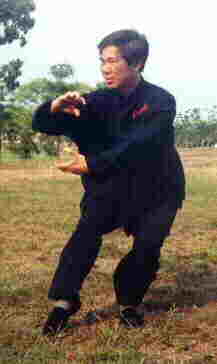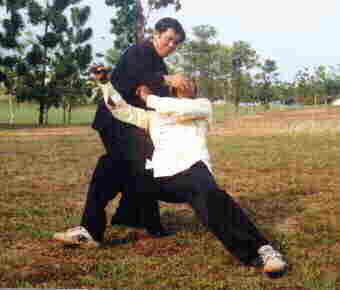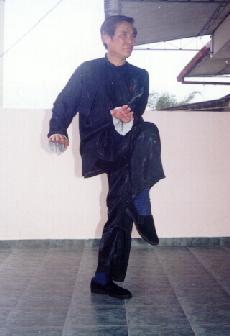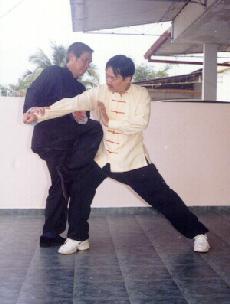July 2003 (Part 1)
SELECTION OF QUESTIONS AND ANSWERS

All kungfu patterns, including those which appear flowery, have combative functions. This Shaolin pattern, called “Double Dragons Carry Pearl”, for example, is a deadly technique in the hands of a genuine kungfu exponent
Question 1
I have been developing my own style for quite some time now. It is not really a style in the traditional sense, but a compilation of techniques, strategies and tactics that I have found useful that I have picked up over time sparring with others and learning with others.
— Phil, USA
Answer
You do so because you have not experienced any art to any depth. You merely scratch its surface but think that is all the art can offer.
A traditional art has been developed by masters over many centuries. No matter how smart you are, you would not be smarter than generations of masters put together. Most probably you are not even half as good as an average student of the art.
For example, no matter how smart you are, it is most unlikely for you to discover from your own and your friends' experiences that by remaining stationary at one poise you can develop internal force, by performing certain movements you can generate an internal energy flow, or by regulating your breathing you can spar for a few hours without being tired. Yet, students at my intensive courses not only learn these abilities but actually are able to do them within a few days.
Was I that smart to discover these methods myself? No, I am not so unwise to imagine myself smarter than generations of past masters put together. I am very lucky to inherit their methods and generous enough to impart them to my students.
Question 2
I've tried schools, but I've always felt limited by them. However, I'm also convinced that most styles contain a lot of material that does not work very well in real life situations, and that learning these excessive “flowery fists and embroidered legs” only leads to trouble in the real world.
Answer
If you are referring to kungfu or wushu schools, most schools today teach “flowery fists and embroidered legs”, which are external kungfu forms meant to please spectators but cannot be used for fighting.
If your objective were to learn beautiful forms for demonstration, you would not be able to attain a small fraction of the elegance and beauty students of these schools could perform if you experimented on your own. If your objective is fighting, you are right to say that developing your own style from your own fighting or sparring experiences, is more effective than learning from these schools.
But if students of these schools also learn to fight, although what they use in sparring is not kungfu or wushu forms but usually techniques borrowed or stolen from other martial systems, then whether your self-created style is more effective or not, depends on various factors. These factors include the amount and quality of sparring practice, experience in real-life fighting, as well as how much combatants are willing to punish themselves in taking blows.
The fault with “flowery fists and embroidered legs” is not their forms, but the inability of the practitioners to use them for combat. All traditional kungfu forms, including those that appear highly flowery, have combative functions. It is when practitioners do not know how to use them for combat but use them for demonstration, that they become “flowery fists and embroidered legs”.
Similarly, all the material taught in a genuine kungfu school is meant for real life situations, otherwise it would not be taught. In a good school, the application is not just for combat; more importantly it is to enhance daily work and play. If a student does not know how to use any material, such as a technique, a skill or a principle, it is not because it cannot work well in real life, but because the instructor is incompetent.

Sifu Wong applies the pattern “Double Dragons Carry Pearl” on Mogan
Question 3
In addition, I don't feel that there is such a thing as “one style fits all.” What I mean is that certain traditional and not-so-traditional styles may be good for those who developed them, but not necessarily perfect for those who are taught them.
Answer
If your term of reference is combat efficiency, you are right in your opinion if the style is incomplete, but wrong if the style is complete.
Some examples of what I would call incomplete styles are Karate, Taekwondo, Muay Thai, Kickboxing, Western Boxing and Wrestling. I do not mean any disrespect to these styles, and I would emphasize that an exponent of an incomplete style, in some situations, can be a better fighter than an exponent of a complete style.
What I mean is that there are certain combative techniques not included in the repertoire of an incomplete style. Hence Karate may be good for Karatekas who developed Karate, but may not be perfect for Wrestlers whom are taught Karate. In other words, if you are a Karate exponent, you can defend yourself well if your opponent uses Karate techniques to attack you, but you may be at a loss if he attacks you with Wrestling techniques.
On the other hand, virtually all kungfu styles are complete. In other words, the repertoire of a kungfu style provides sufficient material for the kungfu exponent to defend against any attack.
If you are a genuine kungfu exponent, irrespective of your kungfu style, if your opponent uses kungfu techniques to attack you, you can defend yourself well. If he uses Karate, Taekwondo, Muay Thai, Kickboxing, Western Boxing, Wrestling or other techniques to attack you, you too can defend yourself well. Hence, traditional kungfu styles are good for those who developed them, and also good for those who are taught them — provided, of course, they are taught genuine traditional kungfu.
Notwithstanding this, it does not necessarily mean that one style fits all. For various reasons, some may prefer Wing Choon Kungfu, others may prefer Praying Mantis, whereas still others may find learning Karate or Kickboxing more beneficial than learning a kungfu style.
Question 4
Studying martial arts always improves one's performance, but I think this mostly has to do with strategy, doing the unexpected (in a fight), speed, and power — all things that are readily taught in schools. These things can also be learned by an individual on the street, given enough time.
Answer
All the four points you mentioned above are incorrect!
One, practicing martial arts does not always improve one's performance. I would even go to the extent of saying that the way many martial arts are practiced today is detrimental to one's performance — in combat as well as in daily living. The amount of internal injuries one has sustained as well as his attitude in totally disregarding his own safety in sparring practice are serious negative factors in any performance.
Two, the two most important factors in any successful performance are mental clarity and harmonious energy flow, the two factors that are usually neglected and sometimes totally unknown in many martial arts practiced today. You may have good techniques, tactics and strategies, but if your mind is dull and your energy blocked, your speed and power as well as efficiency will be seriously affected in combat or daily work.
Three, mental clarity and harmonious energy flow, as well as strategies, doing the unexpected, speed, and power are not readily taught in schools. What typical schools readily teach you are techniques, which are often taught badly too. You are expected to use the same techniques against a young child or a tough adult, which means you are not taught strategies. You are expected to defend yourself the way others do, which means you are not taught doing the unexpected. You are not taught how to regulate your breathing according to the combat situations, which means you are not taught the fundamentals of speed and power.
Four, these things cannot be, and should not be, learned by an individual on the street. Even if we presume that they could be learnt on the street, he would not have any time. How often have you fought on the street to enable you to learn good strategies, doing the unexpected, speed and power? How likely would someone approach you with a gift, but suddenly pull out a dagger and thrust it into your stomach? A good fighter would escape unhurt because he has learnt and trained these things from his masters, who in turn has inherited them from generations of past masters.
Question 5
Everyone seems to agree that you must learn from a master, but I've got two problems with that. My first problem is that the title “master” is an honorary one. It is quite obvious that there are so-called masters out there that can be defeated by some street fighters or mixed-martial artists.
Answer
You haven't met any real masters, you have met only honorary or faked ones. This is no surprise. Real masters are rare. In terms of fighting abilities, street fighters are nowhere compared to real masters.

This Taijiquan pattern becomes a form of “flowery fists embroidery legs” if the practitioner does not know how to apply it for combat. But it can be very combat effective if used by a competent martial artist.
Question 6
My second problem is that if it is true that a master's presence is necessary for mastery of self-defense, then masters of martial arts have existed since the beginning of time, with all the knowledge that current masters have today with them back then. Of course this is impossible, and we know that every generation comes up with new techniques. Someone had to come up with many of these techniques without the help of a master.
Answer
Did you learn English grammar in school, or science? While the English language is changing and new scientific discoveries are made all the time, we need masters of English and of science. You may try learning English grammar or science on your own through your own experience and experiments, but that will be very silly of you. You do not make good use of the immense amount of knowledge accumulated over centuries.
The same principle of making use of accumulated knowledge applies to learning a martial art. But in the case of kungfu there is one big difference. Our best attainment in kungfu today is not even a tiny percentage of that attained by masters in the past.
Many people have kindly said I have attained much in kungfu. But what I have attained is not a fraction of what past masters could do. This is not being modest; it is being truthful. My present attainment is possible because I humbly and faithfully followed the teachings of my masters, as well as benefited from the writings of past masters as recorded in kungfu classics.
If you are serious about kungfu, what you should do is to humbly and faithfully follow the teachings of the past masters, and hope to achieve even a portion of what they had achieved. This is not being self-degrading, it is being wise. If you can achieve just one-hundredth of what past masters could do, your achievement would be very remarkable by modern standard. You simply have no idea of what past kungfu masters could do. For a comparison, scientists today admit that they only understand less than one percent of the known world.
If you think you are smarter than the masters and develop your own fighting style which you believe is better than theirs, you are not just being conceited but silly. You are offered a treasure, but instead of accepting it and counting your blessings, you go into the streets hoping to find another treasure but hurting yourself in the process.
Question 7
What I am asking is for you to please tell me whether you agree with what I have said, and if not, why? Do I have to study under a master, or do I have to go to a “martial arts academy” to learn how to fight well? Am I just fooling myself?
Answer
My answers above show that I disagree with what you have said, and why. As illustrated above, your exposure is limited, and your thinking is clouded. You are disappointed with the many schools and martial artists you have seen. As you are intelligent, ambitious and diligent, you want to work out your own fighting system.
Many people have done that and are dong that, and a few have reached remarkable results. The most celebrated example is Bruce Lee, who became an outstanding fighter. Yet, considering the time and effort he had devoted to training, his attainment was not much compared to what genuine kungfu has to offer.
Yes, you are fooling yourself. Do not misunderstand that I am trying to run down your opinions. In fact I like your questions, and you have asked respectfully and sincerely to seek for answers.
There are many ways to learn how to fight well. But the best way is to learn from a master. You must make sure he is a real master. Besides fighting efficiency, there are many wonderful things you can learn from him, such as good health and vitality, longevity, mental clarity and inner peace.

Sifu Wong applies the seemingly flowery Taijiquan pattern illustrated earlier on Goh Kok Hin. As the application here may suggest, this Taijiquan pattern is called “Throw Knee at Chest”
Question 8
I have been training in the Yip Mann style of Wing Chun for several years, but I will be living in different parts of East Asia for a long period where Wing Chun is not available. I am interested in the martial arts for self defence and health, but I still haven't found that I am very methodical about learning. I like the straight-line theory of Wing Chun and am not interested in hopping between martial arts schools. I also feel that martial art is an integral part of my life and I want to keep it as a lifelong pursuit.
So my question is: if I am in Shanghai or Japan (for example) should I learn the style that is there, or should I keep learning Wing Chun in private without an instructor? Or if I am in Southern China should I learn a different style of Wing Chun?
— Tse, Canada
Answer
Your question may be of interest to many people in similar situations.
The following “formula” would be helpful.
- Define your general aims and specific objectives.
- Estimate, basing on your past experience in your Wing Chun training, how well you can attain your aims and objectives.
- Look around to see if there are other means, such as learning from a master of another Wing Chun style or another kungfu style, or attending my Intensive Shaolin Kungfu Course, to enhance the attainment of your aims and objectives.
- Take one alternative means at a time and list on a piece of paper the extra benefits you would get if you pursue this alternative means.
- Considering the time, effort and money you have to invest, choose the best of the available alternative means.
- Practice the chosen alternative means for some time, say three months, but at the same time you also continue with your normal Wing Chun training. You may, for example, spend four days a week on your alternative means and two on Wing Chun, or 45 minutes a day on the alternative means and 15 minutes on Wing Chun.
- Then decide on one of the following course:
- Continue to practice your Wing Chun Kungfu and forget about the others.
- Continue to practice your Wing Chun Kungfu but practice the alternative means as a supplement or for fun.
- Change the alternative means as your main means to attain your aims and objective, and forget about the others, including Wing Chun Kungfu.
- Change the alternative means as your main means but also practice Wing Chun Kungfu as a supplement or for fun.
If your general aims in practicing a martial art as a lifelong pursuit are self defence and health, Wing Chun Kungfu will fulfill your needs quite well. Your specifc objectives may be to perform a Wing Chun set elegantly and forcefully yet without feeling tired, and to be familiar with some Wing Chun techniques in applying the straight-line theory.
But if you have other aims and objectives, such as wishing to experience what internal force really is and how it may enhance your work and play, or how you can be more methodical in learning a martial art or in your daily life, you may have to look elsewhere for help.
Question 9
I was wondering if there is any sort of boundary where learning different styles of kung fu would be detrimental at a master's level. I know that learning different styles is a hindrance to a beginner's progress, but at a master's level, I imagine that you may learn different styles without too much interference? I'm wondering specifically if one can learn tiger claw qin-na after one has gained proficiency in Taijiquan, since I get the impression that Hoong Ka's tiger claw qin-na is superior or more well developed than Taijiquan's qin-na.
— Chia, USA
Answer
There is no hard and fast answer to your question. Usually it is beneficial for a master to learn different styles, but sometimes it may not be so.
As a master is already skilful and since skills are generally transferable, i.e. if he is fast and powerful in Taijiquan, he is also fast and powerful in Hoong Ka. Learning more techniques from other styles will enlarge his repertoire of techniques. Tiger Claw is a good example.
If the master applies his Taijiquan qin-na (special gripping techniques) on another Taijiquan opponent, such as applying “Playing the Lute” to grip the opponent's arm, the opponent may be able to counter them, such as countering with a shoulder strike. But if he applies Hoong Ka qin-na techniques, which are more sophisticated as you have rightly observed, such as “White Monkey Catches Pig”, simultaneously gripping the opponent's wrist and two vital points at the waist, the opponent would find it much harder to counter.
On the other hand, the time the master spent in learning Hoong Ka techniques might be better spent in further enhancing his Taijiquan techniques and skills. For example, although Hoong Ka qin-na techniques are more sophisticated, by perfecting his simpler Taijiquan qin-na techniques to such a highly skillful level, the master can be so fast and forceful that as soon as he applies “Playing the Lute” to grip the opponent' arm, the opponent could not neutralize it, although in theory he knows how to.
